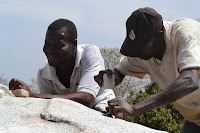On Sunday 10th February Team
Sandema took a day trip to Navrongo, the capital of the Kassena-Nankana District
to explore the famous Catholic Mud Cathedral. We travelled to our desired
destination in our favourite mode of transport, the tro tro*. Known for being
overcrowded and uncomfortable, the tro tro journey was surprisingly smooth.
Despite Will having half of his derrière hanging out of the window and a few
bumped heads due to the never ending pot holes, we arrived in Navrongo in one
piece… just about.
 |
| Getting cosy on the tro tro |
Upon arrival our tro tro was mobbed by a group of eager passengers. As soon as the rusty door was pulled open, men, women, children and babies dove onto the tro tro to claim their seats. Fighting, pushing, screaming and shouting, Team Sandema were helplessly stuck in the back, whilst a grown man scrambled through the back window and a woman threw her baby onto a seat. Bemused and a little frightened (lets be honest), we managed to push our way through the boarding passengers and alight the bus. Will and I managed to escape, whilst Poppy and Tracy were still trapped in tro tro hell.
Noticing a little white hand reach out from
the mass of bodies, Will grabbed it and out emerged Poppy, followed by Tracy
who angrily voiced her views to the passengers. “These people seriously need to learn how to form a
queue!” Once we calmed down from our traumatic travel experience, we walked to
a roadside food stall and relaxed with a well-deserved egg sandwich. A bloody
big one too, as Poppy’s order of ‘three egg with bread’ resulted in a three-egged
sandwich, each. Filled with egg until
next week, we then ventured into the town centre and met our rock, Mr. Festus.
Festus has a close friend from Navrongo, Martin,
who also joined us and acted as our tour guide for the day. We asked him to take
us the Mud Cathedral, which he was happy to do. “Of course!” he said. “It’s not
that far, we can walk there”. Note to self; never listen to a Ghanaian when
they say ‘it’s not that far’. After an hour or so walking in the sweltering
Ghanaian sun, desperately seeking shade and a toilet that wasn’t a hole behind
a mud wall, we finally reached the Mud Cathedral. It was an enjoyable walk*,
but it reminded me of when I was younger when my family and I would travel to
Cornwall in the car, and I could be constantly asking my dad, “Are we
theeeeeere yet?”
 |
| Taking the scenic route |
As we entered the cathedral grounds we were
welcomed by angelic choir singing coming from one of the rooms, which was a
suitable backing track as we turned the corner and clapped eyes on the beautiful
Mud Cathedral towering above us, looking like a perfect sand castle. Feeling
very much like tourists we paced the building taking lots of photos and posing for
the camera in front of the bell tower.
 |
| Tourist photo - me outside the Mud Cathedral |
The Mud Cathedral was organised by three missionaries, the ‘White Fathers’, who travelled from Burkina Faso to Navrongo in 1906. The White Fathers, who were French-Canadian, initially desired to settle in Paga, but were moved onto Navrongo as they were thought to be slave traders and were not trusted. They were eventually permitted land in the forest by the people of Navrongo, but were only allowed to stay if they established peace with the animals.
Once this was evident they began their
‘catholic mission’ and built a small chapel in 1907, followed by a slightly larger
chapel in 1910. The striking Mud Cathedral was later built and completed in
1920 and is still used for worship today. The interior of the cathedral is very
impressive with the walls decorated with catholic symbolisms and animal
engravings to represent the animals the three Father’s lived amongst.
 |
| Poppy and Will get holy |
The long journey to the mud cathedral was worth it in the end and Team Sandema and I had a lovely day. We braced ourselves for the long trek back to Navrongo town centre, only for Martin to take us on a short cut that brought us into town in less than half an hour. Cheers for telling us about that shortcut, Martin. Much appreciated.
*Massive
lie
- Jenna






























